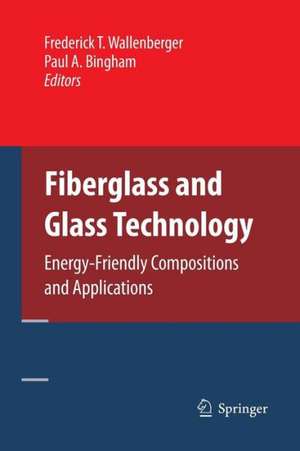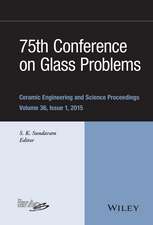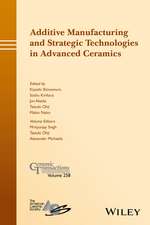Fiberglass and Glass Technology: Energy-Friendly Compositions and Applications
Editat de Frederick T. Wallenberger, Paul A. Binghamen Limba Engleză Paperback – 3 sep 2014
This book consists of two complementary sections: continuous glass fiber technology and soda-lime-silica glass technology. Important topics covered include:
o Commercial and experimental compositions and products
o Design of energy- and environmentally-friendly compositions
o Emerging glass melting technologies including plasma melting
o Fiberglass composite design and engineering
o Emerging fiberglass applications and markets
Fiberglass and Glass Technology: Energy-Friendly Compositions and Applications is written for researchers and engineers seeking a modern understanding of glass technology and the development of future products that are more energy- and environmentally-friendly than current products.
| Toate formatele și edițiile | Preț | Express |
|---|---|---|
| Paperback (1) | 934.33 lei 6-8 săpt. | |
| Springer Us – 3 sep 2014 | 934.33 lei 6-8 săpt. | |
| Hardback (1) | 940.53 lei 6-8 săpt. | |
| Springer Us – 14 dec 2009 | 940.53 lei 6-8 săpt. |
Preț: 934.33 lei
Preț vechi: 1139.43 lei
-18% Nou
Puncte Express: 1401
Preț estimativ în valută:
178.83€ • 187.61$ • 148.35£
178.83€ • 187.61$ • 148.35£
Carte tipărită la comandă
Livrare economică 29 ianuarie-12 februarie 25
Preluare comenzi: 021 569.72.76
Specificații
ISBN-13: 9781489984791
ISBN-10: 1489984798
Pagini: 492
Ilustrații: XV, 474 p.
Dimensiuni: 155 x 235 x 26 mm
Greutate: 0.68 kg
Ediția:2010
Editura: Springer Us
Colecția Springer
Locul publicării:New York, NY, United States
ISBN-10: 1489984798
Pagini: 492
Ilustrații: XV, 474 p.
Dimensiuni: 155 x 235 x 26 mm
Greutate: 0.68 kg
Ediția:2010
Editura: Springer Us
Colecția Springer
Locul publicării:New York, NY, United States
Public țintă
Professional/practitionerCuprins
Continuous Glass Fibers.- Commercial and Experimental Glass Fibers.- Design of Energy-Friendly Glass Fibers.- Composite Design and Engineering.- Glass Fibers for Printed Circuit Boards.- High-Strength Glass Fibers and Markets.- Soda-Lime-Silica Glasses.- Compositions of Industrial Glasses.- Design of New Energy-Friendly Compositions.- Glass Melting Technology.- Basics of Melting and Glass Formation.- Thermodynamics of Glass Melting.- Glass Melt Stability.- Plasma Melting Technology and Applications.
Notă biografică
Dr. Wallenberger completed his undergraduate studies in Chemistry at the University in Graz, Austria (1954) and pursued graduate research at Fordham University in New York, where he received his M.S. degree (1956) in pilot process research and his Ph.D. in Organic Chemistry (1958) in the chemistry of polycyclic aromatic carbon precursors. He was an Instructor in Chemistry at Fordham (1957-58) and a Research Fellow at Harvard (1958-59). He joined Du Pont Fibers, Pioneering Research Laboratory, in 1959, where he studied, for more than three decades, the relationships between structures, properties and value-in-use of new materials, and contributed to the commercialization of new fibers, polymers and composites through intrapreneurial research, project management and technology transfer. Dr. Wallenberger retired from DuPont in 1992, became a Research Professor (Materials Science) at the University of Illinois in Urbana-Champaign in 1992, a Visiting Professor (Textiles) at the University of California in Davis in 1994. He joined PPG in Pittsburgh as Staff Scientist in 1995.
Dr. Wallenberger is a fiber scientist, an expert in the fields of advanced glass, ceramic and carbon fibers, single crystal fibers, whiskers and nanotubes, natural fibers, advanced polymers and fiber-reinforced composites. He is also a specialist in technology assessment and technology transfer. At the University of Illinois, he jointly taught successive project-based team courses with a member of the business faculty on the principles of organizing new high tech businesses. At the University of California he taught textile fibers and manufacture, and a University-wide course on the benefits of plastics to the society and their impact on the environment. Between 1992 and 1995, he was a consultant and assisted entrepreneurial start-up businesses with organizational advice, business strategy and license negotiations.
Since 1957, Dr. Wallenberger has contributed 152publications including journal articles, books, book chapters and patents to the scientific and technical literature. His publications appeared in selected technical journals, including Science, the Journal of Non-Crystalline Solids, the American Ceramic Society, Applied Physics, Materials Letters, Materials Processing and Manufacturing Science, Chemical Vapor Deposition, Angewandte Chemie, Organic Chemistry and Polymer Chemistry. More recently, his publications described the design of environmentally friendly fiberglass compositions (Journal of Non-Crystalline Solids, 2004, Ceramic Transactions, 2004, and Glastechnische Berichte - Glass Science and Technology, 2004), the structure of glass fibers (Science, 1995), rapid prototyping directly from the vapor phase (Science, 1994), pure carbon fibers from the vapor phase (Science, 1993) and melt spinning of amorphous alumina fibers (Journal of the American Ceramic Society, 1992). Ten of his original journal papers were reprinted by other journals since 1962, mostly in the form of a translation into another language.
Dr. Wallenberger has published three books, "Natural Fibers, Polymers and Composites" (Kluwer, 2003), "Advanced Fibers, Plastics and Composites" (MRS, 2002) and "Advanced Inorganic Fibers" (Kluwer, 1999). He wrote a chapter on "Glass Fibers" (Handbook on Ceramics and Glasses, 2005), two chapters on "Reinforcing Fibers" (ASM Composites Handbook, 2001), a survey of "Melt-Spinning of Amorphous Alumna Fibers" (American Ceramic Society Bulletin, 1991) and the first review of "The Chemistry of Heat Resistant Polymer Fibers" (Angewandte Chemie, 1964).
Among many professional honors, Dr. Wallenberger received the Environmental Respect Award from Du Pont. He is a Fellow of the American Ceramic Society, and a member of the American Chemical Society, the Material Research Society, and the Association of Harvard Chemists.
Dr. Paul A. Bingham received a BEng (Hons) in 1995 fromthe Department of Engineering Materials at the University of Sheffield. Also at the Department of Engineering Materials, one of the world's premier glass research groups, he subsequently investigated the optical properties, the redox behavior, and the structure of iron-containing silicate glasses, and received his PhD in 1999.
Between 1999 and 2003 he was a Technologist at Glass Technology Services Ltd (GTS), the research arm of the British Glass Manufacturers Confederation, and carried out a wide range of research and project management functions related to the development of new glasses. He reformulated existing container glasses for environmental benefit and energy reduction, and giver glass compostions which he developed have achieved full-scale production. In 2004, he took a position as Postdoctoral Research Associate at the Immobilization Science Laboratory (ISL), University of Sheffield, where he researches composition-structure-property relations for a large range of glass systems with the aim of providing environmental benefit. He has developed novel silicate, borosilicate, phosphate and borophosphate glasses with potential applications in waste immobilization and commercial glassmaking.
Dr. Bingham has nine publications in refereed journals including several papers in the field of glasses for environmental benefit and an invited review paper on the vitrification of toxic wastes. He has also published several conference papers and other articles in the field. Dr. Bingham is a member of the Society of Glass Technology, where he is Secretary of the Basic Science and Technology Committee. He has also undertaken consultancy work for the optical communications industry.
Dr. Wallenberger is a fiber scientist, an expert in the fields of advanced glass, ceramic and carbon fibers, single crystal fibers, whiskers and nanotubes, natural fibers, advanced polymers and fiber-reinforced composites. He is also a specialist in technology assessment and technology transfer. At the University of Illinois, he jointly taught successive project-based team courses with a member of the business faculty on the principles of organizing new high tech businesses. At the University of California he taught textile fibers and manufacture, and a University-wide course on the benefits of plastics to the society and their impact on the environment. Between 1992 and 1995, he was a consultant and assisted entrepreneurial start-up businesses with organizational advice, business strategy and license negotiations.
Since 1957, Dr. Wallenberger has contributed 152publications including journal articles, books, book chapters and patents to the scientific and technical literature. His publications appeared in selected technical journals, including Science, the Journal of Non-Crystalline Solids, the American Ceramic Society, Applied Physics, Materials Letters, Materials Processing and Manufacturing Science, Chemical Vapor Deposition, Angewandte Chemie, Organic Chemistry and Polymer Chemistry. More recently, his publications described the design of environmentally friendly fiberglass compositions (Journal of Non-Crystalline Solids, 2004, Ceramic Transactions, 2004, and Glastechnische Berichte - Glass Science and Technology, 2004), the structure of glass fibers (Science, 1995), rapid prototyping directly from the vapor phase (Science, 1994), pure carbon fibers from the vapor phase (Science, 1993) and melt spinning of amorphous alumina fibers (Journal of the American Ceramic Society, 1992). Ten of his original journal papers were reprinted by other journals since 1962, mostly in the form of a translation into another language.
Dr. Wallenberger has published three books, "Natural Fibers, Polymers and Composites" (Kluwer, 2003), "Advanced Fibers, Plastics and Composites" (MRS, 2002) and "Advanced Inorganic Fibers" (Kluwer, 1999). He wrote a chapter on "Glass Fibers" (Handbook on Ceramics and Glasses, 2005), two chapters on "Reinforcing Fibers" (ASM Composites Handbook, 2001), a survey of "Melt-Spinning of Amorphous Alumna Fibers" (American Ceramic Society Bulletin, 1991) and the first review of "The Chemistry of Heat Resistant Polymer Fibers" (Angewandte Chemie, 1964).
Among many professional honors, Dr. Wallenberger received the Environmental Respect Award from Du Pont. He is a Fellow of the American Ceramic Society, and a member of the American Chemical Society, the Material Research Society, and the Association of Harvard Chemists.
Dr. Paul A. Bingham received a BEng (Hons) in 1995 fromthe Department of Engineering Materials at the University of Sheffield. Also at the Department of Engineering Materials, one of the world's premier glass research groups, he subsequently investigated the optical properties, the redox behavior, and the structure of iron-containing silicate glasses, and received his PhD in 1999.
Between 1999 and 2003 he was a Technologist at Glass Technology Services Ltd (GTS), the research arm of the British Glass Manufacturers Confederation, and carried out a wide range of research and project management functions related to the development of new glasses. He reformulated existing container glasses for environmental benefit and energy reduction, and giver glass compostions which he developed have achieved full-scale production. In 2004, he took a position as Postdoctoral Research Associate at the Immobilization Science Laboratory (ISL), University of Sheffield, where he researches composition-structure-property relations for a large range of glass systems with the aim of providing environmental benefit. He has developed novel silicate, borosilicate, phosphate and borophosphate glasses with potential applications in waste immobilization and commercial glassmaking.
Dr. Bingham has nine publications in refereed journals including several papers in the field of glasses for environmental benefit and an invited review paper on the vitrification of toxic wastes. He has also published several conference papers and other articles in the field. Dr. Bingham is a member of the Society of Glass Technology, where he is Secretary of the Basic Science and Technology Committee. He has also undertaken consultancy work for the optical communications industry.
Textul de pe ultima copertă
Fiberglass and Glass Technology: Energy-Friendly Compositions and Applications provides a detailed overview of fiber, float and container glass technology with special emphasis on energy- and environmentally-friendly compositions, applications and manufacturing practices which have recently become available and continue to emerge. Energy-friendly compositions are variants of incumbent fiberglass and glass compositions that are obtained by the reformulation of incumbent compositions to reduce the viscosity and thereby the energy demand. Environmentally-friendly compositions are variants of incumbent fiber, float and container glass compositions that are obtained by the reformulation of incumbent compositions to reduce environmentally harmful emissions from their melts. Energy- and environmentally-friendly compositions are expected to become a key factor in the future for the fiberglass and glass industries.
This book consists of two complementary sections: continuous glass fiber technology and soda-lime-silica glass technology. Important topics covered include:
o Commercial and experimental compositions and products
o Design of energy- and environmentally-friendly compositions
o Emerging glass melting technologies including plasma melting
o Fiberglass composite design and engineering
o Emerging fiberglass applications and markets
Fiberglass and Glass Technology: Energy-Friendly Compositions and Applications is written for researchers and engineers seeking a modern understanding of glass technology and the development of future products that are more energy- and environmentally-friendly than current products.
This book consists of two complementary sections: continuous glass fiber technology and soda-lime-silica glass technology. Important topics covered include:
o Commercial and experimental compositions and products
o Design of energy- and environmentally-friendly compositions
o Emerging glass melting technologies including plasma melting
o Fiberglass composite design and engineering
o Emerging fiberglass applications and markets
Fiberglass and Glass Technology: Energy-Friendly Compositions and Applications is written for researchers and engineers seeking a modern understanding of glass technology and the development of future products that are more energy- and environmentally-friendly than current products.
Caracteristici
An in-depth review & discussion of new environmentally friendly E-glass fibers An update of important specialty glass fibers for use at high temperature, electronic, corrosion resistant composites An in-depth review of optical fiber physics, applications materials and production methods Includes supplementary material: sn.pub/extras






